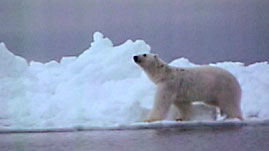Teachers' Domain - Digital Media for the Classroom and Professional Development
User: Preview

Source: U.S. Department of Energy, Office of Science, Atmospheric Radiation Measurement Program
This video, adapted from material provided by the ECHO partners, shows the changes now happening in Barrow, Alaska, due to global warming. The Iñupiaq people who live in Barrow present their observations of these changes based on their centuries-old knowledge of their environment, and describe how these changes are already affecting their lives. Scientists who have come to Barrow to study climate change also offer their perspective.
Arctic Climate Perspectives (Audio Description) (Video)
The global climate is changing at a rapid pace. Although historical environmental change could be attributed to natural causes, recent patterns indicate that human activities are the dominant factor in the current change in climate. In the past 50 years, the accumulation of increasing amounts of greenhouse gases in the atmosphere—such as CO₂ released through the burning of fossil fuels—has caused the average global temperature to increase. Nowhere is this more evident than in the Arctic, where many changes are already impacting the environment and all forms of life that depend on it.
In the past few decades, the annual average Arctic temperature has increased at almost twice the rate as that of the rest of the world. Evidence of this warming can be seen in the widespread melting of glaciers and sea ice, shortening of the snow season, rising sea level, melting of the permafrost, and other changes. This is causing reductions in some wildlife populations, unusual algae blooms, increased forest growth and more intense and frequent forest fires, unprecedented insect outbreaks, and more.
Why does the Arctic warm faster than lower-latitude regions? Many reasons have been proposed. One key reason is that as the snow and ice melt from the rise in temperature produced by increased greenhouse gases, the newly exposed darker land and ocean surfaces absorb more of the Sun's energy (which used to be reflected by the ice), further increasing Arctic warming. The melting of the sea ice also means that solar heat absorbed by the oceans in summer is more easily transferred to the atmosphere in winter.
The Iñupiaq people of Barrow, Alaska—who depend on subsistence whale hunting for nutritional and economic needs and as the basis for cultural and social identity—have already been experiencing these climate changes. The thinning sea ice is often not strong enough to hold a bowhead whale when it is pulled out of the water. Changes in the ice are also dangerous to the hunters, some of whom have needed helicopter rescues when the ice they were on unexpectedly broke off from the shore and floated out to sea. The receding sea ice also exposes the shoreline to increased erosion and flooding, endangering homes and jeopardizing or destroying ancient sites containing valuable cultural data.
However, it is not just the physical environment that is threatened in Barrow. The Iñupiat depend on their ability to predict events in their surroundings—knowledge passed on over centuries of careful observation by their ancestors and elders—to hunt and care for their community. When this critical knowledge no longer applies to their surroundings, it affects their survival. For example, Iñupiaq hunters have always been able to tell when ice is thick enough to hunt safely and to support the weight of a caught whale. Changes in how the ice forms make it difficult for hunters to judge its strength, which jeopardizes their safety and ability to hunt. The Iñupiat now face the difficult challenge of adapting to these changes in order to continue their way of life.
Although residents of the Arctic are among the first to feel the physical effects of global warming, they will not be alone for long. Changes in the Arctic will have major implications for the rest of the globe. For example, as the snow and sea ice continue to melt—causing the Arctic surface to absorb rather than reflect increasing amounts of the Sun's energy—global warming will accelerate. The melting of glaciers and the increase in precipitation in the Arctic will also increase the amount of fresh water that is carried by rivers into the Arctic Ocean. This increase will gradually change the overall circulation and salinity (salt content) of the oceans, which will affect the entire global climate. Melting glaciers also contribute to global sea-level rise. An increase of only a few inches will affect all plants, animals, and humans living in coastal environments. If warming trends continue unabated, the climate changes now being felt by those in the Arctic will have devastating consequences for all human societies. Altering the warming trend may be possible, but it will be a long-term process and will involve a global effort.
 Loading Standards
Loading Standards Education through Cultural and Historical Organizations (ECHO) offers you resources on Teachers' Domain that strengthen knowledge of local culture and identity.
Education through Cultural and Historical Organizations (ECHO) offers you resources on Teachers' Domain that strengthen knowledge of local culture and identity.
